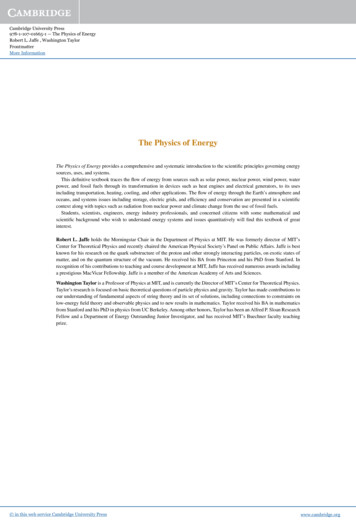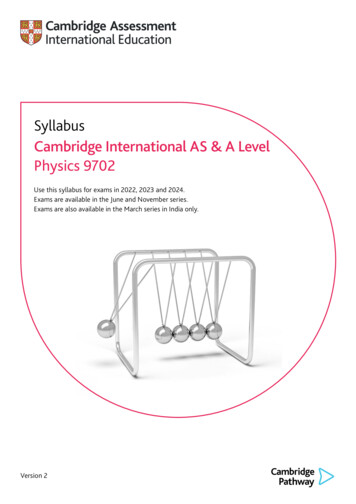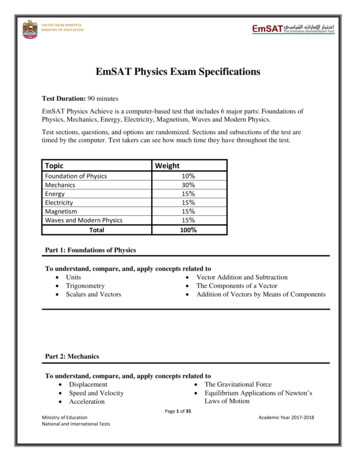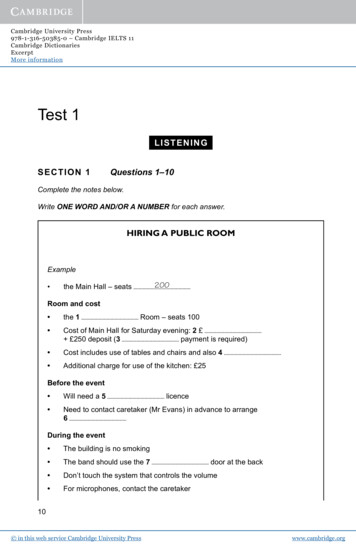
Transcription
Cambridge University Press978-1-107-01665-1 — The Physics of EnergyRobert L. Jaffe , Washington TaylorFrontmatterMore InformationThe Physics of EnergyThe Physics of Energy provides a comprehensive and systematic introduction to the scientific principles governing energysources, uses, and systems.This definitive textbook traces the flow of energy from sources such as solar power, nuclear power, wind power, waterpower, and fossil fuels through its transformation in devices such as heat engines and electrical generators, to its usesincluding transportation, heating, cooling, and other applications. The flow of energy through the Earth’s atmosphere andoceans, and systems issues including storage, electric grids, and efficiency and conservation are presented in a scientificcontext along with topics such as radiation from nuclear power and climate change from the use of fossil fuels.Students, scientists, engineers, energy industry professionals, and concerned citizens with some mathematical andscientific background who wish to understand energy systems and issues quantitatively will find this textbook of greatinterest.Robert L. Jaffe holds the Morningstar Chair in the Department of Physics at MIT. He was formerly director of MIT’sCenter for Theoretical Physics and recently chaired the American Physical Society’s Panel on Public Affairs. Jaffe is bestknown for his research on the quark substructure of the proton and other strongly interacting particles, on exotic states ofmatter, and on the quantum structure of the vacuum. He received his BA from Princeton and his PhD from Stanford. Inrecognition of his contributions to teaching and course development at MIT, Jaffe has received numerous awards includinga prestigious MacVicar Fellowship. Jaffe is a member of the American Academy of Arts and Sciences.Washington Taylor is a Professor of Physics at MIT, and is currently the Director of MIT’s Center for Theoretical Physics.Taylor’s research is focused on basic theoretical questions of particle physics and gravity. Taylor has made contributions toour understanding of fundamental aspects of string theory and its set of solutions, including connections to constraints onlow-energy field theory and observable physics and to new results in mathematics. Taylor received his BA in mathematicsfrom Stanford and his PhD in physics from UC Berkeley. Among other honors, Taylor has been an Alfred P. Sloan ResearchFellow and a Department of Energy Outstanding Junior Investigator, and has received MIT’s Buechner faculty teachingprize. in this web service Cambridge University Presswww.cambridge.org
Cambridge University Press978-1-107-01665-1 — The Physics of EnergyRobert L. Jaffe , Washington TaylorFrontmatterMore InformationA long awaited book which comprehensively covers the fundamentals that engineers, scientists and others specializing inenergy related fields need to master. Wonderfully written, it unlocks and presents the science behind energy systems in apure yet accessible manner, while providing many real world examples to help visualize and frame this knowledge. Thisbook would serve as an excellent text for a foundational course in energy engineering.Khurram Afridi, Department of Electrical, Computer and Energy Engineering, University of Colorado BoulderFinding the energy to power a civilization approaching 10 billion people without unacceptable consequences to the environment is the greatest challenge facing humanity this century. This book develops all of the fundamental concepts inphysics underlying a quantitative understanding of energy sources, interconversion, and end usage, which are essentialparts of meeting this challenge. It will serve as unique and authoritative textbook for the teaching of these topics. . . .Overall it is a masterful exposition of the fundamental concepts of physics and their application to the energy-environmentproblem.Michael J Aziz, Gene and Tracy Sykes Professor of Materials and Energy Technologies,Harvard John A. Paulson School of Engineering and Applied SciencesThe textbook by Jaffe and Taylor is an invaluable resource, for instructors and students alike, discussing the physics ofenergy, a subject that is most important for humankind. . . . The book has great potential as a teaching text for emergingcourses on energy physics and promises to become a classic for years to come.Katrin Becker and Melanie Becker, Texas A&M UniversityJaffe and Taylor have produced in a single volume a comprehensive text on energy sources, energy conversion technologies,and energy uses from the unifying vantage of physics. Either in a course or in self-study The Physics of Energy can serveas the foundation for an understanding of conventional and renewable energy technologies.Paul Debevec, Professor Emeritus, Department of Physics, University of IllinoisJaffe and Taylor have compiled a comprehensive treatise that covers all aspects of energy: its fundamental role in physics,its sources and its uses. In addition to serving as the backbone for a variety of courses, this book should be an invaluableresource for anyone interested in the physics of energy in all of its forms.David Gross, Chancellor’s Chair Professor of Theoretical Physics, Kavli Institute for TheoreticalPhysics, University of California, Santa Barbara, Joint Winner of the Nobel Prize for Physics, 2004The book can be very useful as a mid-level textbook, as a survey for self-instruction for the serious-minded energy policyanalyst, or as a desk reference covering the physics of the full range of energy topics – everything from the energy contentof biofuels, to safe nuclear reactor design, to efficient design and placement of wind turbines, to geothermal energy flow,and dozens more topics . . . This book very effectively fills a gap between the plentiful simplistic treatments of energyissues and books for full time professionals in the various energy areas.Rush Holt, CEO of the American Association for the Advancement of Science, former Member of CongressWe live in an age of wonders, when a designer in almost any engineering field can find a dizzying assortment of tools,materials, components, and construction technologies for building. . . . The Physics of Energy answers the question ofwhere to begin. No engineer’s library will be complete without a copy of this literary and intellectual masterpiece. Abrilliant story of the foundations of everything.Steven Leeb, Professor of Electrical Engineering and Computer Science, Massachusetts Institute of TechnologyThe book is the only comprehensive discussion of energy sources, flows, and uses that I know of. . . . It is designed as atext for a college level course, or as a refresher for those who already have the background, and is successful in achievingits goal of introducing the student to the science of energy.Burton Richter, Paul Pigott Professor in the Physical Sciences, Emeritus and Director Emeritus,Stanford Linear Accelerator Center, Joint Winner of the Nobel Prize for Physics, 1976This is a unique textbook: broad, deep, and crucially important for our society. . . . [Students] are also inspired by newinsights into nature and everyday life: no other energy book covers heat pumps, spark ignition engines, climate change,wave/particle duality and the Big Bang.Joshua Winn, Princeton University in this web service Cambridge University Presswww.cambridge.org
Cambridge University Press978-1-107-01665-1 — The Physics of EnergyRobert L. Jaffe , Washington TaylorFrontmatterMore InformationThe Physics of EnergyRO B E RT L . JA F F EMassachusetts Institute of TechnologyWA S H I N G TO N TAY L O RMassachusetts Institute of Technology in this web service Cambridge University Presswww.cambridge.org
Cambridge University Press978-1-107-01665-1 — The Physics of EnergyRobert L. Jaffe , Washington TaylorFrontmatterMore InformationUniversity Printing House, Cambridge CB2 8BS, United KingdomOne Liberty Plaza, 20th Floor, New York, NY 10006, USA477 Williamstown Road, Port Melbourne, VIC 3207, Australia314–321, 3rd Floor, Plot 3, Splendor Forum, Jasola District Centre, New Delhi – 110025, India79 Anson Road, #06–04/06, Singapore 079906Cambridge University Press is part of the University of Cambridge.It furthers the University’s mission by disseminating knowledge in the pursuit ofeducation, learning, and research at the highest international levels of excellence.www.cambridge.orgInformation on this title: www.cambridge.org/9781107016651DOI: 10.1017/9781139061292c Robert L. Jaffe and Washington Taylor 2018 This publication is in copyright. Subject to statutory exceptionand to the provisions of relevant collective licensing agreements,no reproduction of any part may take place without the writtenpermission of Cambridge University Press.First published 2018Printed in the United Kingdom by Bell and Bain Ltd, January 2018A catalogue record for this publication is available from the British Library.ISBN 978-1-107-01665-1 HardbackCambridge University Press has no responsibility for the persistence or accuracy ofURLs for external or third-party internet websites referred to in this publicationand does not guarantee that any content on such websites is, or will remain,accurate or appropriate. in this web service Cambridge University Presswww.cambridge.org
Cambridge University Press978-1-107-01665-1 — The Physics of EnergyRobert L. Jaffe , Washington TaylorFrontmatterMore InformationTo our parents, our teachers,our spouses and, most of all,to our children in this web service Cambridge University Presswww.cambridge.org
Cambridge University Press978-1-107-01665-1 — The Physics of EnergyRobert L. Jaffe , Washington TaylorFrontmatterMore InformationContentsPrefaceAcknowledgmentsPart IBasic Energy Physics and Usespage xvxx11Introduction1.1Units and Energy Quantities1.2Types of Energy1.3Scales of EnergyDiscussion/Investigation QuestionsProblems35699102Mechanical Energy2.1Kinetic Energy2.2Potential Energy2.3Air Resistance and Friction2.4Rotational MechanicsDiscussion/Investigation QuestionsProblems111213192224243Electromagnetic Energy3.1Electrostatics, Capacitance, and Energy Storage3.2Currents, Resistance, and Resistive Energy Loss3.3Magnetism3.4Electric Motors and Generators3.5Induction and Inductors3.6Maxwell’s EquationsDiscussion/Investigation QuestionsProblems2729354145485253534Waves and Light4.1Waves and a Wave Equation4.2Waves on a String4.3Electromagnetic Waves4.4Energy and Momentum in Electric and Magnetic Fields4.5General Features of Waves and Wave EquationsDiscussion/Investigation QuestionsProblems56565861626367675Thermodynamics I: Heat and Thermal Energy5.1What is Heat?5.2Pressure and Work5.3First Law of Thermodynamics5.4Heat Capacity5.5Enthalpy697074777881 in this web service Cambridge University Presswww.cambridge.org
Cambridge University Press978-1-107-01665-1 — The Physics of EnergyRobert L. Jaffe , Washington TaylorFrontmatterMore InformationviiiContents5.6Phase TransitionsDiscussion/Investigation QuestionsProblems8285866Heat Transfer6.1Mechanisms of Heat Transfer6.2Heat Conduction6.3Heat Transfer by Convection and Radiation6.4Preventing Heat Loss from Buildings6.5The Heat EquationDiscussion/Investigation QuestionsProblems888889961001021061067Introduction to Quantum Physics7.1Motivation: The Double Slit Experiment7.2Quantum Wavefunctions and the Schrödinger Wave Equation7.3Energy and Quantum States7.4Quantum Superposition7.5Quantum Measurement7.6Time Dependence7.7Quantum Mechanics of Free Particles7.8Particles in PotentialsDiscussion/Investigation 8Thermodynamics II: Entropy and Temperature8.1Introduction to Entropy and the Second Law8.2Information Entropy8.3Thermodynamic Entropy8.4Thermal Equilibrium and Temperature8.5Limit to Efficiency8.6The Boltzmann Distribution8.7The Partition Function and Simple Thermodynamic Systems8.8Spontaneous Processes and Free EnergyDiscussion/Investigation 9Energy in Matter9.1Energy, Temperature, and the Spectrum of Electromagnetic Radiation9.2A Tour of the Internal Energy of Matter I: From Ice to Vapor9.3A Tour of the Internal Energy of Matter II: Molecular Vibrations, Dissociation, and Binding Energies9.4Internal Energy, Enthalpy, and Free Energy in Chemical Reactions9.5Chemical Thermodynamics: ExamplesDiscussion/Investigation QuestionsProblems16216316416717317718018010Thermal Energy Conversion10.1Thermodynamic Variables, Idealizations, and Representations10.2Thermodynamic Processes in Gas Phase Engines10.3Carnot Engine10.4Stirling Engine10.5Limitations to Efficiency of Real Engines10.6Heat Extraction Devices: Refrigerators and Heat PumpsDiscussion/Investigation QuestionsProblems183185187191193198198201201 in this web service Cambridge University Presswww.cambridge.org
Cambridge University Press978-1-107-01665-1 — The Physics of EnergyRobert L. Jaffe , Washington TaylorFrontmatterMore InformationixContents11Internal Combustion Engines11.1Spark Ignition Engines and the Otto Cycle11.2Combustion and Fuels11.3Real Spark Ignition Engines11.4Other Internal Combustion CyclesDiscussion/Investigation ge Energy Conversion12.1Advantages of Phase Change in Energy Conversion Cycles12.2Phase Change in Pure Substances12.3The Real World: Engineering Nomenclature and Practical CalculationsDiscussion/Investigation QuestionsProblems21922022323023323413Thermal Power and Heat Extraction Cycles13.1Thermodynamics with Flowing Fluids13.2Heat Extraction and the Vapor-compression Cycle13.3The Rankine Steam Cycle13.4Low-temperature Organic Rankine Systems13.5Gas Turbine and Combined CyclesDiscussion/Investigation QuestionsProblems235236238246253254258259Part II261Energy Sources14The Forces of Nature14.1Forces, Energies, and Distance Scales14.2Elementary Particles14.3The Weak Interactions and β-decayDiscussion/Investigation QuestionsProblems26326526927527827815Quantum Phenomena in Energy Systems15.1Decays and Other Time-dependent Quantum Processes15.2The Origins of Tunneling15.3Barrier Penetration15.4Tunneling Lifetimes15.5The Pauli Exclusion PrincipleDiscussion/Investigation QuestionsProblems27928028028328528728928916An Overview of Nuclear Power16.1Overview16.2Nuclear Fission Fuel Resources16.3The Following ChaptersDiscussion/Investigation QuestionsProblems29129229429729729817Structure, Properties, and Decays of Nuclei17.1Basic Nuclear Properties17.2The Semi-empirical Mass Formula17.3Nuclear Binding Systematics17.4Nuclear DecaysDiscussion/Investigation QuestionsProblems299300303307312320320 in this web service Cambridge University Presswww.cambridge.org
Cambridge University Press978-1-107-01665-1 — The Physics of EnergyRobert L. Jaffe , Washington TaylorFrontmatterMore InformationxContents18Nuclear Energy Processes: Fission and Fusion18.1Comparing Fission and Fusion18.2Cross Sections18.3Physics of Nuclear Fission18.4Physics of Nuclear FusionDiscussion/Investigation QuestionsProblems32332332432533533934019Nuclear Fission Reactors and Nuclear Fusion Experiments19.1Nuclear Fission Reactor Dynamics19.2Physics Issues Affecting Fission Reactor Operation and Safety19.3Breeding and Fission Reactors19.4Fission Reactor Design: Past, Present, and Future19.5Nuclear Reactor Power Cycles19.6Experiments in Thermonuclear FusionDiscussion/Investigation zing Radiation20.1Forms of Ionizing Radiation: An Overview20.2Interactions of Radiation with Matter20.3Measures of Radiation20.4Biological Effects of Radiation20.5Radiation in the Human Environment20.6Nuclear Waste and Nuclear ProliferationDiscussion/Investigation gy in the Universe21.1What is Energy?21.2A Brief History of Energy in the UniverseDiscussion/Investigation QuestionsProblems40440441542042122Solar Energy: Solar Production and Radiation22.1Nuclear Source of Solar Energy22.2Blackbody Radiation and Solar Radiation22.3Derivation of the Blackbody Radiation FormulaDiscussion/Investigation QuestionsProblems42242342542843043023Solar Energy: Solar Radiation on Earth23.1Insolation and the Solar Constant23.2Earth’s Orbit23.3Variation of Insolation23.4Interaction of Light with Matter23.5Atmospheric Absorption23.6Extent of ResourceDiscussion/Investigation r Thermal Energy24.1Solar Absorption and Radiation Balance24.2Low-temperature Solar Collectors24.3Concentrators24.4Solar Thermal Electricity (STE)Discussion/Investigation QuestionsProblems446447451453459462462 in this web service Cambridge University Presswww.cambridge.org
Cambridge University Press978-1-107-01665-1 — The Physics of EnergyRobert L. Jaffe , Washington TaylorFrontmatterMore InformationxiContents25Photovoltaic Solar Cells25.1Introductory Aspects of Solid-state Physics25.2Quantum Mechanics on a Lattice25.3Electrons in Solids and Semiconductors25.4The PV Concept and a Limit on Collection Efficiency25.5Band Structure of Silicon25.6p-n Junctions25.7The p-n Junction as a Photodiode25.8Silicon Solar Cells25.9Advanced Solar Cells25.10 Global Use of PhotovoltaicsDiscussion/Investigation 49249226Biological Energy26.1Energy and Photosynthesis26.2Food Energy26.3Biomass26.4Biofuels26.5The Future of BioenergyDiscussion/Investigation QuestionsProblems49449549950250451151251227Ocean Energy Flow27.1Oceanic Energy Balance and Transport27.2Coriolis Force27.3Surface Currents27.4Atmospheric Circulation27.5Ocean Circulation27.6Ocean Thermal Resources and Ocean Thermal Energy Conversion (OTEC)Discussion/Investigation : A Highly Variable Resource28.1The Nature of the Wind28.2Characterization of a Wind Resource28.3The Potential of Wind EnergyDiscussion/Investigation QuestionsProblems53153354455055455429Fluids: The Basics29.1Defining Characteristics of a Fluid29.2Simplifying Assumptions and Conservation Laws29.3Viscosity29.4LiftDiscussion/Investigation QuestionsProblems55655755956456757557530Wind Turbines30.1Axial-momentum Theory and Betz’s Limit30.2Turbine Blades and Power30.3Some Design ConsiderationsDiscussion/Investigation QuestionsProblems57757858258859059031Energy from Moving Water: Hydro, Wave, Tidal, and Marine Current Power31.1Hydropower31.2Wave Power31.3Tidal Power591591595609 in this web service Cambridge University Presswww.cambridge.org
Cambridge University Press978-1-107-01665-1 — The Physics of EnergyRobert L. Jaffe , Washington TaylorFrontmatterMore InformationxiiContents31.4Marine Current EnergyDiscussion/Investigation QuestionsProblems61661761732Geothermal Energy32.1Thermal Energy in Earth’s Interior32.2Geothermal Energy Resources32.3Ground Source Heat Pumps32.4Hydrothermal Energy32.5Enhanced Geothermal Systems (EGS)32.6Magnitude of Geothermal ResourcesDiscussion/Investigation il Fuels33.1Coal33.2Petroleum33.3Natural Gas33.4Hydrocarbon Conversion33.5Fossil Fuel SummaryDiscussion/Investigation QuestionsProblems645647657669675676677677Part III679Energy System Issues and Externalities34Energy and Climate34.1Albedo and the Greenhouse Effect34.2Atmospheric Physics34.3Global Energy Flow34.4CO2 and the Carbon Cycle34.5Feedbacks and Climate ModelingDiscussion/Investigation �s Climate: Past, Present, and Future35.1Past Climate35.2Predicting Future Climate35.3Effects of Climate Change35.4Mitigation and AdaptationDiscussion/Investigation QuestionsProblems70971072472973673973936Energy Efficiency, Conservation, and Changing Energy Sources36.1First Law Efficiency36.2Second Law Efficiency36.3Example: The Efficiency of Space Heating36.4Exergy36.5Efficiency and Conservation Case Studies36.6Energy Systems: Scales and TransformationsDiscussion/Investigation gy Storage37.1Performance Criteria for Energy Storage37.2Grid-scale Storage37.3Mobile Energy Storage37.4Other Energy Storage SystemsDiscussion/Investigation QuestionsProblems775776776782792797797 in this web service Cambridge University Presswww.cambridge.org
Cambridge University Press978-1-107-01665-1 — The Physics of EnergyRobert L. Jaffe , Washington TaylorFrontmatterMore InformationxiiiContents38Electricity Generation and Transmission38.1Overview of Electric Grids38.2LRC Circuits38.3Grid-scale Electricity Generation38.4Transmission and Distribution of Electric Power38.5Renewables: Variable and Distributed Energy ResourcesDiscussion/Investigation QuestionsProblemsAppendix ANotation800801803807814823827827830Appendix BSome Basic Mathematics833Appendix CUnits and Fundamental Constants842Appendix DData844ReferencesIndex in this web service Cambridge University Press846857www.cambridge.org
Cambridge University Press978-1-107-01665-1 — The Physics of EnergyRobert L. Jaffe , Washington TaylorFrontmatterMore InformationPrefaceThis book provides a comprehensive introduction toenergy systems for individuals interested in understanding the fundamental scientific principles underlying energyprocesses from sources to end uses.Origins and UsesThe Physics of Energy emerged from a one-semestercourse with the same title that we developed and havetaught at MIT (Massachusetts Institute of Technology)since 2008. The course serves as an introduction to energyscience in a new energy curriculum at MIT and is opento students who have completed freshman calculus, a yearof physics with calculus, and a term of college chemistry. Although particularly suited to students majoring inhard sciences or engineering, many students who havetaken the course were interested primarily in economicsand policy. The MIT course also serves as an elective forphysics majors, where the concepts developed in more formal courses are brought together into a broader context andapplied to real-world problems.Finding no existing book that matched the level of ourcourse and the approach we wished to take, we began togenerate lecture notes for “The Physics of Energy” in 2007.Those lecture notes slowly expanded in scope and depthinto this book, which has developed a coherent structurein its own right. Because the students in the course havea wide range of backgrounds, we do not assume an extensive amount of physics background. Our goal in the course,and in the book, is to take students from a basic freshmanphysics background to a qualitative and quantitative understanding of both the physical principles underlying allenergy systems and an appreciation of how these ideas areinterconnected and relevant for practical energy systems.This book can be used in many ways. It can serve asa textbook for a single-semester course for undergraduates in a broad range of science and engineering fields or in this web service Cambridge University Pressas a “capstone course” for physics undergraduates; theseare the audiences for the MIT course. A course using thisbook could also be tailored primarily to focus on various subsets of the material; depending upon the goals, onecould focus for example on the basic physics underlyingenergy sources, on the aspects most relevant to climate andtwenty-first century energy choices, on renewable energysources, etc. Some specific one-semester paths through thematerial are suggested below. While we continue to teachthe material from this book as a one-semester course atMIT, with roughly one lecture per chapter, this requiresa rather fast pace and many topics are not treated in thefull depth of the material in the book. With more careful and thorough treatment, the book can also serve as thetext for a more advanced two-semester course in energyscience, for example in conjunction with a graduate certificate in energy studies. The book is also designed to beself-contained and suitable for self-study. Anyone with aserious interest in energy and some background in basicmathematics and physics should hopefully find most of thebook accessible.We hope that The Physics of Energy also will serveas a “desk reference” for those who work in energyrelated fields of science, engineering, economics, or policy,who need to be aware of the scientific foundations oftechnologies beyond their own field of specialization.Scope and FocusProviding energy for the world to use in a sustainablefashion is a major challenge for the twenty-first century.Economic considerations and policy decisions will be central to any global attempt to address this energy challenge.For individuals, organizations, and nations to make rationalchoices regarding energy policies, however, a clear understanding of the science of energy is essential. Decisionsmade in the absence of good scientific understanding havewww.cambridge.org
Cambridge University Press978-1-107-01665-1 — The Physics of EnergyRobert L. Jaffe , Washington TaylorFrontmatterMore InformationxviPrefacethe potential to waste vast amounts of effort and money andto adversely affect countless lives and large ecosystems.This book aims to provide an in-depth introduction toenergy systems, from basic physical principles to practicalconsequences in real systems. The goals of the book are toprovide a clear picture of what energy is and how it flowsthrough Earth systems (Part II), how humans use energy(Part I), and how energy systems take energy from natural sources to end uses (Part III). In each of these areas ourgoal is to build a basic understanding of the underlying science, develop a global picture of how the parts fit togetherinto a coherent whole, and to develop sufficient technicalunderstanding to assess energy systems in a quantitativefashion.Introductory textbooks on energy issues typically mixscience, economics, and policy, with the aim of presenting a unified introduction to the subject. Throughout thisbook, however, we focus solely on the science of energyand energy systems and refrain from addressing issues ofeconomics and politics. This is not because we believe economics and policy are unimportant, but instead because webelieve that the science is best conveyed without constantreference to the economic and political context. Thoseaspects of energy studies are well presented in many otherbooks and in other courses in a typical curriculum inenergy studies. Our goal is to help to provide the scientificunderstanding of energy systems that is a prerequisite forany informed discussion of energy choices in the economicand political realm.As the title indicates, our starting point for viewingenergy sources and uses is primarily through the lens ofphysics. Indeed, a secondary goal of the book is to illustrate how the concept of energy unifies virtually all ofmodern physics into a coherent conceptual framework.It is not possible, however, to provide a comprehensiveoverview of energy science and systems without wideningthe discussion to include areas that are traditionally considered the domain of chemistry, biology, earth science,and many fields of engineering. Energy science is, in fact,an excellent example of a subject where traditional academic boundaries are blurred in nearly every application.Rather than limit our perspective and therefore the usefulness of this book, we have chosen to include a significantamount of material that might not ordinarily be construedas “physics.” Overlap with other fields of science is particularly significant in chapters on energy in matter, fossilfuels, geothermal energy, energy and climate, and biological energy, while chapters on engines, heat extractiondevices, nuclear reactors, wind turbines, and photovoltaicsolar cells contain some material usually found in engineering courses. Some topics such as biofuels and fuel in this web service Cambridge University Presscells, at the edges of the conceptual framework of the bookand at the limit of our own expertise, receive only limiteddiscussion. We have, however, included a more extensivediscussion of some aspects of earth science particularly asit relates to issues of present and future climate, since thistopic is of central importance to the future trajectory ofhuman energy use.Throughout the book, we strive to emphasize the underlying physical principles that govern different energy systems. In particular, we develop the basic ideas of quantummechanics, thermodynamics, fluid mechanics, the physicsof oceans and of the atmosphere, and other basic physicalframeworks in enough technical detail that their application to various energy systems can be understood quantitatively as well as qualitatively. We also strive, in sofar as possible, to provide explanations of phenomena inrelatively simple terms from first principles and to maintain a consistent introductory level throughout the book. Areader interested in any specific topic can gain some initialunderstanding from the treatment here of the underlyingprinciples and learn how the topic connects with the rest ofthe energy landscape, but will have to go elsewhere for amore advanced and more detailed treatment of the subject;we have attempted to give a sampling of references that canlead the interested reader further into any particular topic.Confronting such a wide range of topics, one possibility would have been to invite other authors, experts inthose areas farthest from our own expertise, to write aboutthose topics. Instead, we have chosen to try to educate ourselves sufficiently to cover the subject in its entirety. Thisapproach has the advantages that the level and “feel” of thebook is more coherent and uniform, that the pedagogicalprogression is orderly, and that the unity of energy scienceis more apparent. The disadvantage, of course, is that wehave written extensively about areas in which neither ofus is an expert. We have had the help of many colleagues,who have helped us grasp the subtleties of their fields andcorrected many of our misconceptions. Along the way wehave come to ap
Physics, University of California, Santa Barbara, Joint Winner of the Nobel Prize for Physics, 2004 The book can be very useful as a mid-level textbook, as a survey for self-instruction for the serious-minded energy policy analyst, or as a desk reference covering the physics of the full ra










